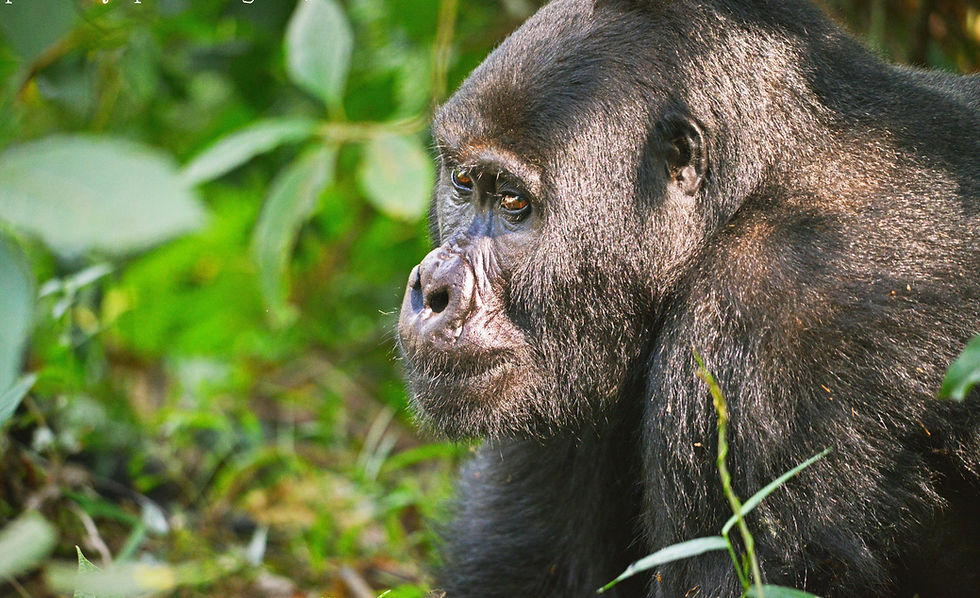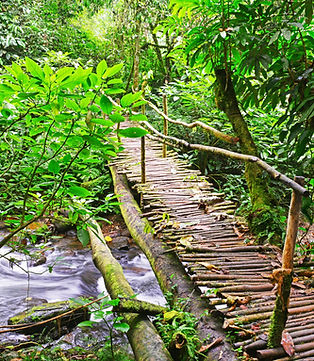Tel/whatsapp +256701302853
Email: info@toturksafaris.com
Roam the Wild. Relish the Journey. Rejoice in the Adventure.

Mountain Gorilla in bwindi
Bwindi Impenetrable National Park
-the home of Mountain Gorillas
Introduction:
Bwindi Impenetrable National Park was established as a National Park in 1991 after undergoing a lot of changes and merges as a Reserve and Sanctuary.
It was listed a UNESCO World Heritage Site in 1994 because of its ecological importance and holds a place of reverence in Uganda's conservation narrative.
The Park was named after the Forest it inhabits, Bwindi Impenetrable Forest and has the reputation of being one of Africa's most dense forests. The name Bwindi comes from a local Runyakitara word Mubwindi which means ''a place full of darkness” because of its dense forests. The term "impenetrable" aptly describes the challenging terrain of the park, its forests that are characterized by tangled vines, thick undergrowth, and dense foliage.
Geography and climate:
It covers an area of 321 km² between 1,160m and 2,607m above sea level. Located in the southwestern region of Uganda, with in the Albertine rift, bordering Democratic Republic of the Congo (DRC) in the west, and Rwanda in the south, Bwindi is a sanctuary of primeval beauty, where mist shrouded hills and tangled vines create an otherworldly atmosphere.
Bwindi is a water catchment area, and much of the forest's rainfall forms streams that pour into its rivers. Five of Bwindi's major rivers feed into Lake Edward.
The forest can be cold, especially in the morning and at night; the annual average temperature range is 7°C to 20°C with the coldest period being June and July. As well as warmth clothing, wet weather gear is essential when visiting the park, since Bwindi receives up to 2,390mm of rain per year.
Biodiversity:
Bwindi's famed inhabitant is a remarkable and endangered primate: the Mountain gorilla. Approximately 50% (as of 2019, 459 individuals), of the world’s mountain gorillas live in Bwindi.
Safaris with Bwindi Impenetrable National Park



Bwindi impenetrable national park

However, the Park’s dense forest is also home to over 120 mammal species like the majestic African elephant, 10 more primate species, the elusive African golden cat, the African giant forest hog, the bush pigs, the common warthogs, duikers and so many more, each mammal species plays a crucial role in the park's intricate ecosystem.
With 98% of their DNA similar to humans, these gentle giants captivate visitors with their majestic presence and familial bonds. Led by dominant silverback males, Mountain gorilla groups traverse the dense montane and bamboo forests, foraging on leaves, shoots, and fruits.
Despite facing threats such as habitat loss and poaching, concerted conservation efforts have seen their numbers increase in recent years, offering hope for their continued survival. Other primates include the chimpanzees, black and white colobus monkeys, L’Hoest monkeys, red tailed monkeys, blue monkeys, and olive baboons among others.
Birdlife
The Park's avian residents are equally captivating, with over 350 bird species, including 23 endemic to the Albertine Rift, like the African Green Broadbill (Pseudocalyptomena graueri), Shelley's Crimsonwing (Cryptospiza shelleyi), Grauer's Rush Warbler (Bradypterus graueri), Yellow-eyed Black Flycatcher (Melaenornis ardesiacus), and the Red-faced Woodland Warbler (Phylloscopus laetus).
The vibrant plumage of turacos, sunbirds, and elusive forest-dwellers add splashes of color to the verdant canopy, creating a symphony of sights and sounds that captivates birdwatchers and nature enthusiasts alike.
Botanical richness
Bwindi is a sanctuary for a rich tapestry of biodiversity, boasting a plethora of plant. Its montane forests harbor over 400 plant species, including towering mahoganies and ancient ferns, providing vital habitat for a diverse array of wildlife.
Gorilla Trekking:
At the heart of Bwindi lies a profound connection between humans and nature, epitomized by the iconic Mountain Gorilla Trekking experience. Adventurers from across the globe embark on arduous journeys through the park's rugged terrain, guided by experienced trackers in search of elusive gorilla families. Encountering these gentle giants in their natural habitat is a truly unforgettable experience.
Bwindi Impenetrable National Park features four sectors for gorilla trekking with a total of 184 permits per day for 23 gorilla families.
The sectors are; Buhoma in the north, (48 permits per day), known for intimate gorilla encounters and cultural experiences with the Batwa community; Ruhija in the east (32 permits per day), offering tranquil surroundings and scenic hiking trails; Rushaga in the south (72 permits per day), renowned for its high density of gorilla families and diverse wildlife; and Nkuringo in the southwest (32 permits per day), boasting panoramic views of the Virunga volcanoes and rugged gorilla trekking adventures. Each sector promises unique and unforgettable experiences amidst Uganda's wilderness.
Gorilla permits can only be purchased at the Uganda Wildlife Authority(UWA) reservations offices in Kampala. Only Licensed Tour Operators can purchase Foreign non resident tracking permits from UWA. For a foreign non resident tracking permit, contact a reputable licensed tour operator.
Park Activities
-
Gorilla trekking
-
Gorilla habituation experience
-
Nature walks and hiking
-
Birdwatching
-
Cultural and community tours
-
Mountain biking and cycling tours
-
Wildlife & butterfly viewing
-
Photography and scenic viewing
Cultural Significance
Bwindi is inhabited by indigenous Batwa communities whose ancestral ties to the forest stretch back millennia. Their traditional knowledge and intimate understanding of the land enrich visitors' experiences during cultural trails, offering insights into age-old customs and the delicate interplay between humans and the natural world.

_JPG.jpg)

_JPG.jpg)
